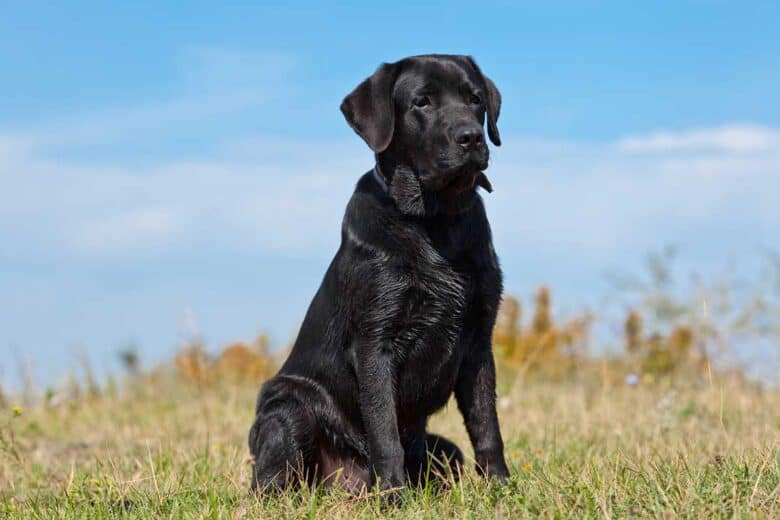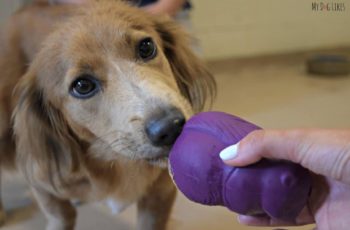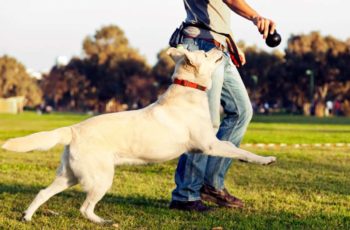This post may contain affiliate links. We may earn money or products from the companies mentioned in this post.
Sometimes I look at photos of my dog when she was small enough to sit in the palm of my hand.
When did she get so big?! Times like those make me wonder, too: how much bigger will she get? Exactly when is my puppy likely to reach her full size and stop growing?
If these sound like questions you have asked yourself, then you are not alone as a pet parent. Puppies change so much in the first months of their lives, but then things slow down. As a result, their changing size can sometimes creep up and surprise you.

Exactly how long it will take for your dog to reach their full size depends on their breed, and them as an individual. Read on as we look at when different types of dogs reach full size and signs that indicate whether your pup may still be growing or has finally stopped.
Contents & Quick Navigation
When Do Puppies Reach Their Full Size?
Puppies can reach their full adult size anywhere between six and 24 months of age. That is a pretty big time bracket, so let’s see if we can narrow it down for different types of dogs.
Smaller dogs tend to reach their full size sooner, and live for longer, while larger dogs tend to take a bit longer to fully mature and have slightly shorter overall lifespans, but these rules do not hold true for all dogs. Below you will find a list of some of the most popular breeds and when you can expect them to reach full size.
Labrador Retrievers
One of the most popular breeds in the United States often used as working dogs, Labrador retrievers measure between 21.5 and 22.5 inches and weigh between 55 and 80 pounds. They tend to reach their full size at around 12 months of age.
Golden Retrievers
Golden retrievers are another dog popular as both family pets and working dogs. They measure between 20 and 24 inches and weigh between 55 and 75 pounds. They will reach their full height at around 12 months.
German Shepherds
Popular as police dogs, affectionate family pets, and guard dogs, German shepherds measure between 22 and 26 inches and weigh 50 to 90 pounds. They are not considered fully grown until they are at least 18 months old.
French Bulldogs
These adorable compassion dogs usually stand about 12 inches tall and can weigh between 16 and 28 pounds (they have a tendency to put on weight when overfed). Unusually for such a small dog, they need 12-14 months to reach their full size.
Bulldogs
A little bigger than their French cousins, people love these dogs for their distinctive faces. They are usually 12 to 15 inches tall and weigh about 15 pounds. It takes them about 18 months to reach their full size, skin rolls and all.
Poodles
Among the most intelligent dogs, poodles are fantastic companions and are often used in mix-breed dogs because of their hypoallergenic coats. While toy and miniature poodles are common, standard poodles are 18-24 inches tall and weigh 45 to 70 pounds. They do not reach their full size until two years of age.
Beagles
These little English hunters with their floppy ears measure 13 to 16 inches and weigh between 20 and 25 pounds. They reach their full size at around 18 months.
Rottweilers
While rottweilers can have a bad reputation because of the ways that they have been used in the past, they are naturally intelligent and non-aggressive. They are big dogs, measuring 22-27 inches and weighing 80 to 130 pounds. They are slow maturing and will only stop growing somewhere between two and three years old.
Daschunds
Sausage dogs come in many shapes and sizes, but all have distinctive long bodies with short legs. The standard size is 14 to 19 inches and can weigh between 12 and 30 pounds. They grow up fast and will reach their full size at around eight months.
Pembroke Welsh Corgis
These little herders from Wales will measure between 10 and 12 inches and weigh between 25 and 30 pounds. Most will be pretty much their full size by one year of age, but they may have additional growth spurts until they are as old as three.
Australian Shepherds
These intelligent working dogs from California (despite the name) measure 18 to 23 inches and weigh between 35 and 70 pounds. They will reach their full size at around 16 months of age.
Yorkshire Terriers
Yorkshire terriers are one of the smallest dog breeds measuring just 8-9 inches and weighing just 4-7 pounds. They stick to the height-related growth rules and will stop growing when they are only 6-8 months old.
Great Danes
Great Danes are great in terms of both their size and their personality. These German kings and queens grow to between 28 and 35 inches and weigh between 110 and 180 pounds. They will keep growing until at least 18 months, and will probably be full size before two years.
Boxers
Boxers are another German dog of medium to large size. They grow to between 21 and 24 inches tall and weigh 55-75 pounds. They will reach their full height somewhere between 18 and 24 months old.
Siberian Huskies
These dogs were bred to pull sleds in cold places, but their cute wolf look makes them popular household pets. They grow to 20-23 inches tall and weigh 35 to 60 pounds. They will reach their full size at 15 months of age.
Cavalier King James Spaniels
These dogs can look a bit bigger than they are thanks to their flowing locks. They will reach between 12 and 13 inches tall and weigh 10-18 pounds. They will reach their full size at around 18 months.
Doberman Pinschers
Regular Doberman pinschers are quite large dogs, measuring 25-28 inches and weighing 70-100 pounds. They will reach their full height at around one year old but will continue to fill out noticeably until around two years old.
Shih Tzu
This Asian toy dog breed from Tibet measures between 8 and 11 inches and weighs 9-15 pounds. They will be their full adult size by the time they are about 10 months old.
Pomeranians
Fluffy Pomeranians are 7-12 inches tall and weigh just 3-7 pounds under all that hair. Most will reach their full size at six or seven months old.
English Mastiffs
English mastiffs are big dogs, measuring around 27-30 inches and weighing up to 230 pounds. They will only reach their full size at about three, but growth slows significantly around the one year mark.
Chihuahuas
Another of the toy breeds, Chihuahuas, hailing from Mexico, measure 6-10 inches and weigh between 4 and 6 pounds. They will reach their full diminutive height by around 9 months of age.
Basset Hounds
The short legs of a basset hound mean that they only grow to about 11-15 inches, but they can weigh as much as 75 pounds. They often won’t reach their full size until they are around two years old.
Maltese
These white balls of love and fur measure 8-10 inches tall and weigh 7-9 pounds under all that hair. They will reach their complete size at 6-8 months old.
Dalmations
Dalmations are known for their distinctive spots, but they are also strong and intelligent dogs. They reach between 19 and 23 inches and have an athletic physique of 45-60 pounds. They will reach their full size at around 16 months of age.
Greyhounds
There is more to these spindly littler racers than it seems. They grow to between 27 and 30 inches and weigh 55-85 pounds. They will reach their full racing height at 13-14 months old.
Mixed breed dogs are likely to reach full size sometimes between the time period for their two purebred parent breeds. If your dog is not on the list, you can compare them with dogs of a similar size for a general guide.
How Do You Know When Your Puppy Is Fully Grown?
If you don’t know the breed of your dog or how old they are, it can be hard to determine whether they are fully grown or still have a few growth spurts in store.
The best thing to look at as a guide is their paws. A dog’s paws will generally be proportional to the structure of their bodies and the amount of weight that they will need to carry, so if your pup’s paws look too big, they probably still have growing to do.
Look at the size of paws of similar dogs to help you determine whether they are the right proportions for your pup.
If you are desperate to know how big your dog will be, you can also do a dog DNA test that can help you narrow down the possibilities.
Factors That Influence The Size Of Your Dog
While breed and genetic hereditary factors are the most important factors when it comes to the size of your dog, there are a few lifestyle factors that may result in your pup being bigger or smaller as well.
Worm Infections
If your puppy becomes infected by hookworms or roundworms as a puppy, this can stunt their growth. The worms steal calories and nutrition from your dog, which means that it is unable to grow the way that it should.
Worm infestations are more common than many people imagine, as they are easily picked up in the environment. Poor coat quality, potbelly, and regular diarrhea are all signs that they may have worms.
Other puppy diseases such as Parvo can also stunt their growth. Most dogs are vaccinated against Parvo, but it can be a problem when they have not yet been vaccinated.
Nutrition
Proper nutrition is essential to your dog’s health or growth, but as long as you are feeding them good quality food, the timing of when you switch from puppy to adult food probably won’t make any difference to their ultimate size.
Prioritize food that is rich in protein and healthy fats, and keep carbohydrate intake under control to ensure they can reach their full size in top health.
Spaying Or Neutering
While many dog owners will tell you that spaying or neutering their dog seems to have stunted their growth, the evidence is anecdotal. In studies that have been run, it seems to have a negligible effect.
It is often a good idea to delay spaying female dogs until they are fully grown, rather than at around six months, but this is to prevent related cancer risks as opposed to size considerations.
Excessive Exercise
Exercising your puppy too much can be detrimental to their growth. While it may not stunt their overall growth, it can cause different parts of their body to grow at different speeds. This can lead to malformations such as elbow and hip dysplasia.
This is most common in larger dogs since the puppies have lots of energy to burn off, but as a general rule, until your dog is fully grown you should exercise them for five minutes per day for each month of their life.
If your dog is six months old, then, they need just half an hour of exercise a day. If they are still growing at one year, they will need just 60 minutes, rather than the 90 minutes they will want when they are a full-grown dog.
You can read more about the right way to exercise Labrador puppies here.
FAQs
Do dogs double in size from six months?
No, at six months old most small dogs will be almost fully grown. Larger dogs, on the other hand, are likely to be about two-thirds of their adult weight at six months. Only very large breeds such as Rottweilers and Great Danes are likely to still be half their adult size at six months.
Do the back legs of puppies grow faster?
It is true that not every part of your dog will grow at the same pace, and it is not unusual for them to be a bit disproportional while they are growing. Puppies often have legs that are too long for their body. It can happen that their hind legs grow faster than their front legs, but this is not an overly common phenomenon.
Do dogs have growth spurts?
Yes, just like humans, dogs don’t tend to grow gradually each day. Rather, they have short rapid growth spurts that make it seem like they grew an inch overnight. They also tend to put on a bit of weight and then lean out as their body goes through its quick growth stage. Their appetite will also increase before a big growth period.
Do dogs’ tails grow longer?
A puppy’s tail will grow with the rest of its body until it reaches its adult height. Tails do not continue to grow over the course of a dog’s life.
How can I increase my puppy’s growth?
If you are worried that your puppy is not growing at a normal rate, you should speak to your vet to see if there really is something wrong. Slower growth could be normal for them. If you want to give your dog the best chance to reach their full size, focus on good nutrition.
Prioritize protein and don’t be afraid to let them eat quite a bit of healthy fat. Often concerned pet parents limit their dog’s fat intake, but they do need quite a bit of it in their diets.
The Verdict
As your adorable puppy seems to just keep getting bigger each day, it is normal to ask yourself when exactly they will stop growing. How long it takes dogs to reach their full size depends significantly on their breed, so there is no single rule for all dogs.
As a general guideline, vets will tell you that small dogs grow quickly and will reach their full size between six months and one year.
Larger dogs grow more slowly and can take up to two years to fully grow, but there are many exceptions to the rule. It is best to research your breed and see what is normal for them. If you have a mixed breed, their age will sit somewhere between the ages of their two parent breeds.
If you don’t know how old your dog is, or what breed they are, the best indicator of whether they are still growing is the size of their paws in relation to the rest of their body. In terms of skeletal growth, paws are generally the thing that the rest of the body is catching up with, though they might still fill out.
Do you have experience dealing with dogs that just don’t seem to stop growing?
Share your thoughts with the community in the comments section below.
Save To Pinterest

Top Picks For Our Dogs
- BEST PUPPY TOY
We Like: Snuggle Puppy w/ Heart Beat & Heat Pack – Perfect for new puppies. We get all of our Service Dog pups a Snuggle Puppy. - BEST CHEW TOY
We Like: KONG Extreme – Great toy for heavy chewers like our Labrador Retrievers. - BEST DOG TREATS
We Like: Wellness Soft Puppy Bites – One of our favorite treats for training our service dog puppies. - BEST FRESH DOG FOOD
We Like: The Farmer’s Dog – A couple months ago we started feeding Raven fresh dog food and she loves it! Get 50% off your first order of The Farmer’s Dog.
For a list of all the supplies we get for our new service dog puppies check out our New Puppy Checklist on the PuppyInTraining.com blog.
How Do You Know When A Puppy Is Fully Grown? was last modified: January 31st, 2022 by


